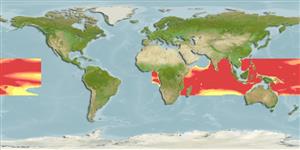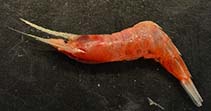Acanthephyra smithi Kemp, 1939
| Native range | All suitable habitat | Point map | Year 2050 |

|
| This map was computer-generated and has not yet been reviewed. |
| Acanthephyra smithi AquaMaps Data sources: GBIF OBIS |
Classification / Names Common names | Synonyms | CoL | ITIS | WoRMS
Malacostraca | Decapoda | Acanthephyridae
Environment: milieu / climate zone / depth range / distribution range Ecology
Bathypelagic; depth range 200 - 3716 m (Ref. 96667). Deep-water; 20°N - 24°S, 2°E - 131°W (Ref. 97331)
Distribution Countries | FAO areas | Ecosystems | Occurrences | Introductions
Indo-Pacific.
Length at first maturity / Size / Weight / Age
Maturity: Lm ? range ? - ? cm Max length : 2.5 cm CL male/unsexed; (Ref. 97331); 2.3 cm CL (female)
Short description Morphology
The large and stout body is covered uniformly with fine pits, which are marks of the attachment of small lanceolate scales. The rostrum is usually shorter than the carapace. The branchiostegal spine is small, supported by a very small carina. A distinct dorsal carina is present on the second to sixth abdominal somites. The carinae of the third to sixth somites ends in large teeth. The telson bears 3 pairs of dorsolateral spines.
Minimum depth from Ref. 96741.
Life cycle and mating behavior Maturity | Reproduction | Spawning | Eggs | Fecundity | Larvae
Members of the order Decapoda are mostly gonochoric. Mating behavior: Precopulatory courtship ritual is common (through olfactory and tactile cues); usually indirect sperm transfer.
Main reference
References | Coordinator | Collaborators
Poupin, J. 1998. (Ref. 75706)
IUCN Red List Status (Ref. 130435)
CITES status (Ref. 108899)
Not Evaluated
CMS (Ref. 116361)
Not Evaluated
Threat to humans
Harmless
Human uses
| FishSource |
Tools
More information
Internet sources
BHL | BOLD Systems | CISTI | DiscoverLife | FAO(Publication : search) | Fishipedia | GenBank (genome, nucleotide) | GloBI | Gomexsi | Google Books | Google Scholar | Google | PubMed | Tree of Life | Wikipedia (Go, Search) | Zoological Record
Estimates based on models
Preferred temperature
(Ref. 115969): 2.9 - 7.4, mean 4.4 (based on 1123 cells).



